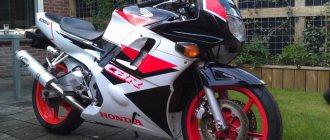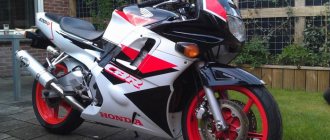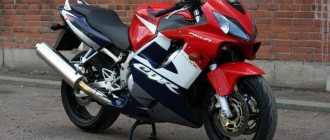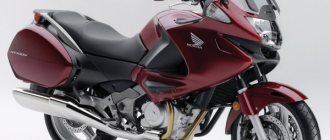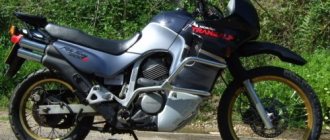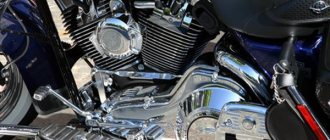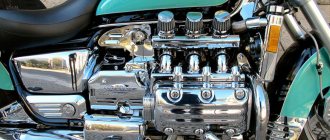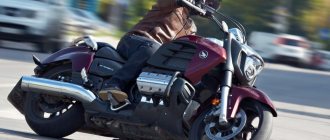- Honda motorcycle model
The Honda CBR600F sports motorcycle model begins its history with the 1987 Honda CBR600F Hurricane model. The model featured a steel frame, narrow wheels and a maximum power of 87 hp.
In 1991, the motorcycle was updated to the next generation - Honda CBR600F2. In addition to the updated appearance, the model receives a new engine (maximum power increased to 100 hp), new wheels, suspension and carburetors.
In 1995, a new generation appeared - the Honda CBR600F3. It gets a more modern appearance, new suspensions, larger front brake discs, and an increased engine compression ratio.
In 1999, the next generation of the model was the Honda CBR600F4. The model receives many changes - a new appearance, an aluminum frame, new adjustable suspension, a wider rear wheel, a new brake system with 4-piston front calipers, a new engine (maximum power 110 hp), new carburetors.
In 2001, the model underwent its final restyling, releasing the most popular model in the series - the Honda CBR600F4i. The main difference from the previous version was the use of an injector (PGM-Fi). Other changes affected overall dimensions, weight (1 kg lighter), increased fuel tank capacity (from 17 to 18 liters), gearbox ratios and generator power (increased from 343 to 433 W).
2006 was the last year of production of the Honda CBR600F4i model, after which it finally left the market. In 2011, Honda decided to resurrect the series by building a new generation - the Honda CBR600F. This model was built on the basis of the latest generation Honda CB600F Hornet and is very different from the previous generation CBR600F.
In 2013, the Honda CBR600F was discontinued, giving way to a new model - the Honda CBR650F
000_moto_0511_042
Honda CBR600F: sports tourer, 2011, 600 cm³, 102 hp, 211 kg, from RUB 450,000.
Honda CBR600F: sports tourer, 2011, 600 cm³, 102 hp, 211 kg, from RUB 450,000.
“Comrades! The workers’ and peasants’ revolution, the need for which the Bolsheviks kept talking about, has come true.” To paraphrase the leader of the world proletariat, I can say “Citizen motorcyclists, a replacement for the good old CBR600F4i has arrived!”
The premiere of the updated CB600F Hornet (“Moto” No. 4–2011) had just died down when its “dressed” modification was presented to journalists for comprehensive review. Strictly speaking, the CBR600F differs from it only in the presence of full-fledged grand prix plastic and clip-ons instead of a bent steering wheel. Suspension settings, gear ratios, injection maps, and even the gas tank and rear plastic with a seat - everything was “moved” from the Hornet without any changes. Such experiments are not new. Suzuki, which built the GSX1250 from the classic “Bandit,” and Yamaha, which built the XJ6 Diversion F sports tourer from the XZ6 naked, expanded the model range in the same way. It is obvious that Honda, when creating such “hybrids”, also does not invest sporting ambitions in completely budget devices. They remain the same quiet cars for every day, just “with checkers”. In the sense that in the eyes of potential buyers of such equipment (and these are mostly novice motorcyclists who are still afraid of real “sports” and mature guys who, on the contrary, no longer need a “hellish hurricane”), a motorcycle with developed wind protection is simply more comfortable than "naked".
From the very first meters, skepticism about the capabilities of the motorcycle quickly dissolved. It seems that a naked bike was built from “Siberian”, and not vice versa. The “triangle” of the landing turned out to be a little sharper than on the Hornet (the clip-ons are installed lower, and the footrests and seat remained in their places), but at the same time, it was the increased tilt of the body that made the landing “just what the doctor ordered” for the existing weight distribution and dimensions of the device. However, the tilt of the body is so slight that the back and wrists do not get tired even after several hundred kilometers of continuous riding. Due to the greater load on the front wheel, the brakes, which on the Hornet clearly lacked information, gained the necessary efficiency and feedback. For the same reason, the motorcycle became much more willing to turn into turns and generally obey the pilot. It’s easier to squeeze through traffic jams thanks to a narrower steering wheel. The only hindrance is the mirrors, mounted on plastic on long legs, but they can be folded “along the sides.”
Unfortunately (and for some, perhaps fortunately), the Sibir’s engine is just as phlegmatic as that of its city “brother”. Up to 8000 rpm you can safely count crows and look at the young ladies passing by, and only after reaching this o. It is clearly not intended for “hellish produbas”, but in quiet urban or suburban mode you can limit yourself to third gear: it covers the speed range of 40–120 km/h quite calmly, the engine is very elastic. For a “six hundred” the operating range is more than decent. In short, the CBR is perfect for everyday city and intercity driving.
HONDA CBR600f4i: "ENERGY OF EVOLUTION"When it comes to judging motorcycles, especially in what is arguably the most competitive class of them all, CBR600F4, ZX6-R, GSXR600, YZF-R6... a veritable alphabet hodgepodge of speeds, things aren't much different. If you add the less race-focused 600s into the mix, you've got about a dozen great street bikes. The choice is yours. These are the best times for motorcycles of this size. However, if you are the type of person who finds it very difficult to make a decision, I really sympathize with you, because the coming years will drive you crazy. If all models were so accessible, then the extinct F3 would definitely be one of the best on the market. Voting with thick wallets in their pockets, motorcyclists from all over the world would opt for it year after year - But Honda is not that company at all , which gets all the laurels. Therefore, we did not expect the CBR600F4 to arrive for testing. We thought, Well, strong guy, show what you can do. However, we left impressed by the ease with which the motorcycle coped with the task. It was accepted by the public and became known for its speed, handling, comfort and reliability.
Honda's mission that year seemed to be to get things right, and it showed in every part and system of the bike. Without the use of expensive exotic materials like carbon fiber or titanium, the manufacturers managed to make the bike strong, powerful and more than 13 kg lighter than the F3. To reduce the weight of the bike, they upgraded everything from the paper-thin instruments , to the frame made of extruded aluminum. The frame is 7kg lighter and has 15% better torsional rigidity than last year's F3. The engine couldn't seem to find a better place than on this bike. A lightweight ignition coil saves even more energy, despite this, the oil cooler has a large capacity. The new one seems to be just as reliable as the old version, and it's also half a kilo lighter than the previous one. A modified alternator and starter saves another half a kilo. Interestingly, Honda actually added 200g to the flywheel to increase torque mass, thus increasing the torque curve that is unique to Honda. Overall, the new F4 weighs noticeably less than the F3's dry weight, a difference you'll feel every time you ride. The new bike feels much faster, more agile, turns better and stops better. The model features a durable Nikasil-coated piston, pioneered on the CBR900rr, as well as RC45 aluminum composite cylinder liners (used on the VFR800) for better wear resistance and superior heat dissipation. Honda's patented CPU ignition provides digital conversion based on data received from a pair of cylinders. In short, it works without a hitch. But there are new, improved CBR powerplants that have thoroughly narrowed the heads by moving the valve and cutting the valve angle from 16 to 13 degrees on the exhaust side and a nearly vertical 11 to 25 degrees on the intake side, paired with a new tuned flat-panel carburetor that keeps your gas flowing. air mixture several thousand times per minute. This mixture, doomed to destruction, is in addition subject to the quibbles of an entire filter system. Frankly, we like the idea of a more powerful and faster engine, we think all engines should have this quality.
On the F4, two bold black wind deflectors protrude like boxing gloves from the front fairing to reduce airflow and improve throttle response. Compressed air enters a sealed air resonator, the volume of which is increased by 15%. The only point in which the F4 has lost in comparison with the F3 is the lower engine output at medium speeds. But this is only a minor point. It's like a small price to pay for a 5% improvement in peak power. The remarkable thing about riding motorcycles of this class (including the F4) is that it gives a kind of mystical transformation from a big cruiser or big sports tourer to a kind of “buzzer”. At first you feel uncomfortable, cumbersome, the subconscious sends a signal: “You're overexcited! » but after an hour you get used to everything, since all the details are very skillfully designed. At very low revs, the F4 is no different from other mid-weight sportbikes, and it also doesn't feel very good when revved at 3,000 rpm. In 6th gear at km/h, the studious clunker is relatively quiet at 5,200 rpm. /min If you want to rush by turning off the gas. just wait a few seconds for the revs to build up to maximum power. Downshift and you'll get enough power to outrun any car. Get into second gear and you'll leave many bikes in the dust. Engage third gear and you will simply, excuse me, be flattened. Such a super-sport acceleration curve would have been unheard of for a bike of this size until recently. In short, the F4 has a hot and eager engine that will do whatever the rider asks of it.
The F4 is a "great" bike for the track, but it's just as good for the street. Ergonomics are just as good as on the F3 (this is quite significant), but the steering wheel has been slightly wider and the grip has been made easier. These and other improvements create a new human-machine interface that is an out-of-this-world experience. Honda managed to tweak the suspension and made a new chassis with its "muscular" fork; The entire system is both robust and responsive. It's a bike that's always a pleasure to ride, whether fast or slow, on country roads or the expressway, solo or two-up, and there's tuning options for the 43mm fork and 40mm rear monoshock to suit any situation and rider. But for those who will ride and not do “tuning”: I rode the F4 for a whole week under all sorts of conditions, and I did all this on an “unadjusted” motorcycle, everything on it was, so to speak, direct from the factory, I did nothing on I didn’t unscrew it except for the handle. Dun lop D207s stick to the road even in crazy corners, while the 4-piston brakes are many times more sensitive and powerful than their 2-piston predecessors. The fat rear wheel and tire combined with the upgraded frame and brakes create a bike that isn't going to rear up in a corner or fight you as you try to hold your line through a corner.
Even at very high speeds, the F4 is a very good machine that will reward a good rider and help compensate for the mistakes of a beginner. It has a hard-to-understand element of “I know this. when I see this "which is often described as a "feeling". You get it in the form of positive emotions when you make a turn or just roll down the highway with the whole world smiling at you, or when you “unscrew” and rush towards the horizon. All I can say is, “Travel on these “feelings” is very good.” However, the new F4 is receiving criticism from my friends and regular users. Many people like to look at the new frame, leaving the so-called body without consideration. Everyone is amazed by the new panel, which makes control more convenient. because all the instruments are in front of your eyes. One tester said: “Eventually. The CBR looks as good as it drives! Not everyone was crazy about the green side covers, but wait a minute, that gives you something to talk about, doesn't it?" In short, it's a thin and super-light design, but the convex plastic cover on the speedometer and tachometer reflects a lot of light and is blinding when the sun is behind you. In addition, in daylight, the small LCD trip meter/odometer is invisible when wearing sunglasses. It doesn't have a fuel gauge, so you have to roughly plan when you can stop to refuel. The F4 is light in weight, making your journey comfortable even if it's a long one, but I've found that it requires extra attention to keep the road on track. This aspect of the motorcycle-rider interface will be a nasty surprise, courtesy of Honda's increased attention to detail.
Another small issue is that the mirrors could have been placed a little higher and wider - even a centimeter in each direction would have made a huge improvement. If you're riding in a "clothing" like an armored Aerosuch suit, you'll find that you can only see your elbows and not the cop chasing you. Finally, we noticed more vibration on the right side of the bike than the left. My friend thinks it's may be due to the clutch cover or muffler, which is installed on the right. At 9000 rpm, you feel the engine working, but you feel it more, as they say, with your legs, rather than with your hands. The thing is that the footpegs are thinner and stronger with tighter rubber than on the F3. You'll feel better driving in Sport mode, but you'll hear more whirring.
Despite these small flaws, I couldn't find a better use for the $7,899 Sibir. The question remains whether the F4 helped Honda defeat the GSX-R600 (Suzuki) during the middleweight motorcycle war. Is it better than the Yamaha R6 or Kawasaki ZX6-R? Let's see. But what is certain is that the F4 is a smashing success as a streetbike.
https://www.motopress.ru
006_moto_0511_042
RESULT. Many will be skeptical about the possibilities of “sport” on a “non-sporty” budget spine frame, simple suspensions and with a dead engine from a classic. Yes, it cannot be compared with evil “sports” designed for track. Honda CBR is an entry-level sportbike. The difference between the F and, say, the RR is about the same as between the Subaru Impreza 1.6 and the WRX STI: despite the external similarity, these are two completely different cars. The first is a “string bag on wheels”, the second is an almost ready-to-rally car.
The CBR is a completely worthy vehicle in which you can drive to the track, drive it to grandma’s in the Tambov region, and feel quite at ease in traffic jams. In addition, a bonneted motorcycle is much more practical than its “naked” counterpart, while being no less comfortable in terms of ergonomics and fit. This is exactly what the CBR600F4i was once like, which was loved precisely for its comfort, tractability and practicality, albeit at the expense of power, dynamics and sportiness.
| TECHNICAL SPECIFICATIONS Honda CBR600F (manufacturer data) | |
| COMMON DATA | |
| Model year | 2011 |
| Wheelbase, mm | 1437 |
| Curb weight, kg | 211* |
| Length × width × height, mm | 2150×740×1150 |
| Ground clearance | 135 |
| Seat height, mm | 800 |
| Gas tank volume, l | 19 |
| Steering column tilt angle, degrees. | 25 |
| Reach, mm | 99 |
| ENGINE | |
| Type | R2, 4T |
| timing belt | DOHC, 4 valves per cylinder |
| Working volume, cm³ | 599 |
| Dimension, mm | 67×42,5 |
| Compression ratio | 12:1 |
| Supply system | fuel injection |
| Cooling system | liquid |
| Starting system | electric starter |
| Max. power, hp at rpm | 102/12000 |
| Max. torque, Nm at rpm | 64/10 500 |
| TRANSMISSION | |
| Clutch | multi-disc, oil bath |
| Transmission | 6-speed |
| main gear | chain |
| CHASSIS | |
| Frame | spinal, aluminum alloy |
| Front suspension | inverted cartridge telescopic fork with adjustable spring preload and rebound hydraulics |
| Pipe diameter, mm | 41 |
| Stroke, mm | 120 |
| Rear suspension | pendulum, with a hydraulic shock absorber with adjustable spring preload and rebound force |
| Stroke, mm | 128 |
| Brake system | hydraulic semi-combined C-ABS (braking of both wheels by pedal) |
| Front brake | 2 discs Ø 296 mm, 2-piston (3-piston*) calipers |
| Rear brake | 1 disc Ø 240 mm, 1-piston caliper |
| Wheels | cast, aluminum alloy |
| Front tire | 120/70 ZR17, tubeless |
| Rear tire | 180/55 ZR17, tubeless |
| * With ABS (standard for RF) | |
The test is organized.
Twin: Honda CBR600F
Clearing the self-diagnosis system memory
To clear the error memory, follow the instructions:
- Turn the engine kill switch to the “RUN” position and the ignition key to the “OFF” position;
- Connect the service connector with a jumper;
- Turn the ignition key to the “ON” position;
- Remove the jumper from the service connector;
- The fault indicator (FI) will illuminate for 5 seconds. While the indicator is on, close the service connector again using the jumper. The self-diagnosis module memory will be considered deleted if the fault indicator goes out and starts flashing.
(!) Attention (!):
- The service connector must be closed while the indicator is on; if you do not have time to close it, the fault indicator will not start flashing;
- Please note that the self-diagnosis module memory will not be deleted if the ignition is turned off before the malfunction indicator starts flashing.
If the malfunction sensor flashes 20 times and goes out, this means that the memory has not been cleared, try this procedure again.
